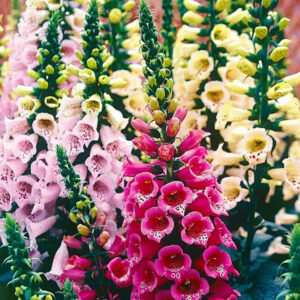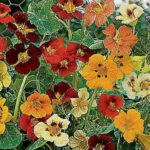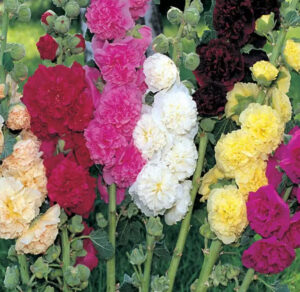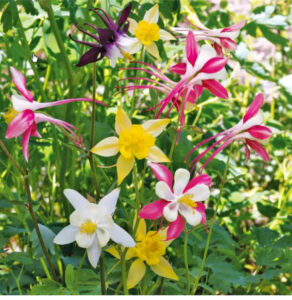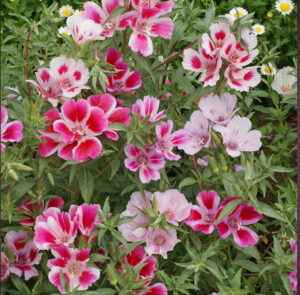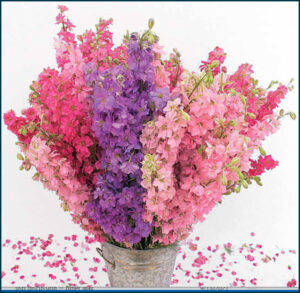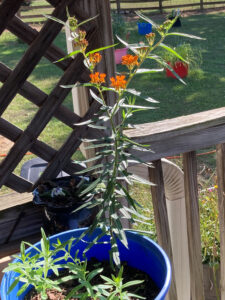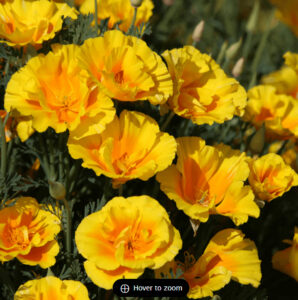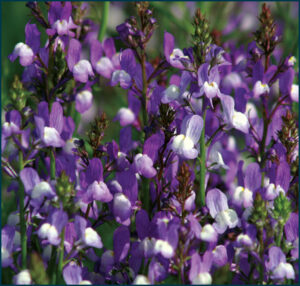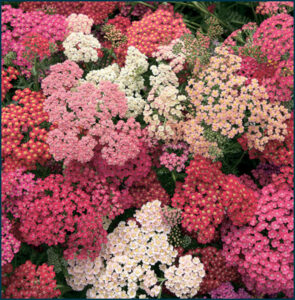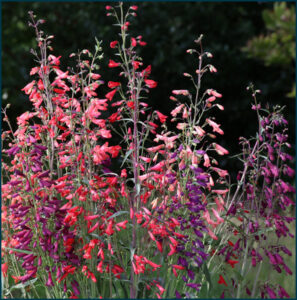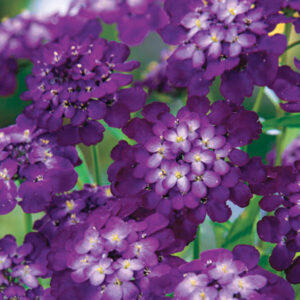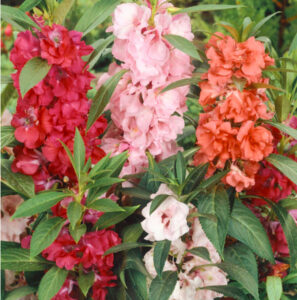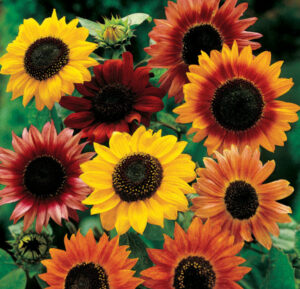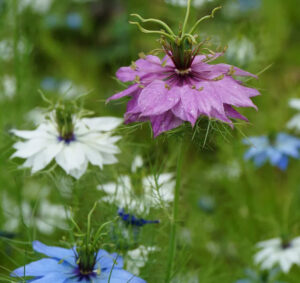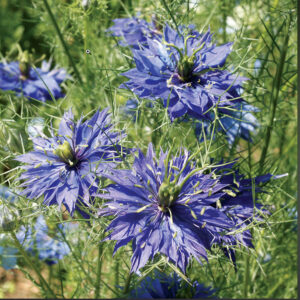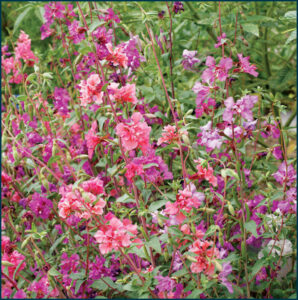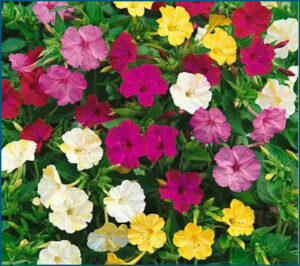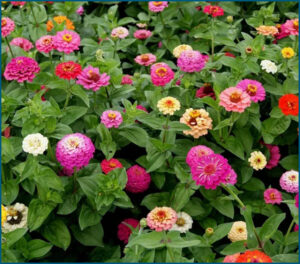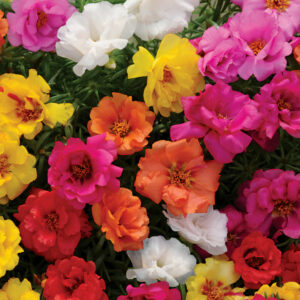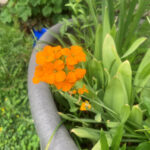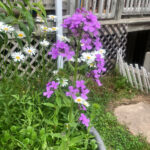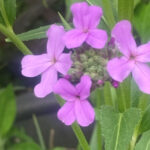| Direct sow in Spring 2022: |
|
Perform best in a rich, moist soil. Full sun – partial shade. Germination: 15-20 days. Height: 3′. Plant Type: Perennial Flower. Days To Bloom: 70 – 100 Days After all danger of frost, sow seeds outdoors. Firm by light tamping. When plants are 4″ high, thin or transplant. Seed Spacing: Sow Hybrid Mixed Colors Excelsior Foxglove seeds roughly 15″-24″ apart. Great for lightly shaded areas. Do not ingest seeds or plants. |
|
Marigold Seeds, French Double Dwarf, 100 seeds, Ferry-MorseThese marigold seeds are easy to grow half-hardy annuals that come in a mixture of colors! These dwarf marigold seeds grow into beautiful half-hardy annual flowers.An All-America Selections winner, several varieties of dwarf French double carnation flowered marigolds entered, but this variety won! Flower features bi-colored, bright mahogany red blossoms stretching 2″ across with gold markings. Blooms early and free.Germination: 5-8 days. Height: 6″-10″. Days To Bloom: 35-50 Days After all danger of frost, sow Dwarf Bolero Marigold seeds in open ground well exposed. Cover with 0.25″ of soil. For earlier blooms, start indoors about 6-8 weeks before the last frost. Cover with 0.25″ of soil. When plants are 2″s high, thin or transplant. Before transplanting, harden off the seedling. Seed Spacing: Sow Dwarf Bolero Marigold seeds roughly 15″ apart. |
|
Neat in the heat, Janie Deep Orange Marigold is both the earliest and most floriferous French marigold we know, earning our highest recommendation for garden performance and nonstop beauty. Beginning just 6 weeks after sowing and continuing all summer long, these rich orange, 2-inch blooms drape the dwarf 8- to 10-inch plants in a soft mantle. Both the blooms and the plant keep their neat shape despite hot weather—this dwarf Janie Deep Orange Marigold reaches just 8 to 10 inches high and 6 to 8 inches wide, with an exceptionally uniform habit. Very free-blooming, Janie Deep Orange Marigold is a great choice for the front of the border, edging, and containers of all types. Even effective as a nematode-repellent in the vegetable garden. And these blooms really bring in the butterflies. Sow direct in the garden Janie Deep Orange Marigold when the soil has warmed, or start seeds indoors in late winter. Very easy to grow in the sunny garden. Bloom Start to End Early Summer – Late Fall |
|
A popular favorite as well as a winner in trial gardens across the country, Super Hero™ Spry Marigold is the AAS winner that made one of the judges exclaim, “I would love to have this in my yard!” A truly beautiful and exceptional crested French marigold with richly colored burgundy and gold blooms, it’s super-easy to grow and a tireless bloomer. What sets Super Hero™ Spry Marigold apart from the dozens of other French marigolds on the market? Here’s what the AAS judges loved: Super Hero™ Spry Marigold is just 8 to 10 inches high and 6 to 8 inches wide, so you can show it off in containers as well as the sunny annual bed. It is also a nice choice for edging the driveway and garden paths. Super Hero™ Spry Marigold is dependable, lower maintenance than any other marigold in the garden, and absolutely beautiful. Like all marigolds, Super Hero™ Spry Marigold is as valuable in the tomato patch as it is in the annual bed and patio container. Marigolds kill nematodes, soil-borne pests that can destroy your tomato plants. So when you grow this beauty, sprinkle a few seeds around your favorite veggies and watch them grow and fruit better than before. Give Super Hero™ Spry Marigold plenty of sunshine and good soil drainage, and keep it watered and fed for nonstop flowers from summer into fall. There’s no harder-working nor more useful annual in garden or container. Super Hero™ Spry Marigold is best direct sown in the warm spring soil, after all danger of frost is past. However, sometimes we just can’t resist starting it indoors for even quicker blooms. If you plan to start your seeds indoors, be sure to check out our Bio Dome Seed Starter Kit. With the Bio Dome, you can control the temperature, light, and soil mix to ensure your seeds become strong for transplant. m Form (P) Pkt of 50 seeds |
|
Shades of gold, orange, yellow, and light orange. Plant Type: Annual Flower. Days To Bloom: 50-60 Days Germination: 5-8 days. Full sun. Height: 30″ After all danger of frost has passed, sow seeds in open ground well exposed. Cover with 0.25″ of soil. When plants are 2″ high, thin or transplant. Before transplanting, harden off the seedling. Plant seeds roughly 12″ apart. Can be used for long-lasting cut flowers. If using as cut flowers, remove foliage to prevent it from rotting in the water. |
|
Variegated foliage and 4 bloom colorsOne of the most elegant nasturtiums we have ever had the pleasure to grow, Jewel of Africa has richly-colored blooms in 4 colors and cream-striped foliage. Together the leaves and flowers create a striking, almost wildly vibrant mix for garden or container.A classic name in nasturtiums, Jewel of Africa is simply unbeatable for rich color and variation on every leaf and bloom. This 4- to 5-foot vining plant is just the right size to tumble from a hanging basket or twine up a small trellis or patio tub. It can even be allowed to trail along the ground, carpeting the garden in color. The pale green leaves are splashed with cream, often developing this variegation late in the season. No two leaves will be just alike. And the flowers are almost as unpredictable—you get cream, yellow, peachy pink, and scarlet all on a single plant, many with blotches or markings near the base of the petals. Magnificent! Both the blooms and the foliage are edible, with a delicious peppery flavor perfect for salads and garnishes. You will want to grow Jewel of Africa in the herb and vegetable garden, where it repels destructive pests such as aphids, beetles, whiteflies, and squash bugs. It’s your edible crops best friend! The heaviest flowering will usually occur in cool weather, but this annual loves sunshine. It grows rapidly and easily from direct-sowing. Select a sunny spot in any garden soil, even poor dry ones, and begin growing one of the most beautiful, useful, and rewarding annuals you will ever see! Jewel of Africa is a marvel that every garden deserves. Bloom Start to End Early Summer – Late Fall |
|
Alaska Mixed Colors Nasturtium flowers have green and white marbled leaves that contrast nicely with its bright 2″ yellow, orange, and crimson blooms. Germination: 7-14 days. Height: 16″-18″. Sun-partial light. Days To Bloom: 32-40 Days After all danger of frost, sow Alaska Mixed Colors Nasturtium flower seeds in open ground well exposed. Cover with .5″ of soil that isn’t too fertile. When plants are 3″ tall, thin. Does not transplant well. Water sparingly. |
|
Hollyhocks: A stunning flowering biennial, 4″ double powder-puff blooms in shades of pink, red, and yellow are long lasting and set lower on the stalk. Treat as biennial. Blooms second year, reseed annually. Both double and semi-double blooms will be produced. Full sun. Germination 10-21 days. Botanical Name: Alcea. Scent: Sweet, Height: 4′-5′ After all danger of frost, sow Summer Carnival Mixed Colors Hollyhock Flower seeds in open ground well exposed. Cover with 0.25″ of soil. Thin when plants are a few inches tall. Transplant roughly 12″ apart. Can be planted in the fall for bloom the following summer. An application of fertilizer in spring is helpful. |
|
This flower thrives in partial sun and rich soil. This columbine variety has showy spurred blooms that come in a range of pink, purple, yellow and white colors including bi-colors that flower in the spring. Plants will bloom in the second year. Botanical Name: Aquilegia, Scent: Soft, sweet. Partial sun. After all danger of frost, sow outdoors. When plants are 3″ high, thin or transplant. Planting Depth: .125″. Seed Spacing: Sow McKana’s Giant Mixed Colors Columbine flower seeds roughly 12″-18″ apart. Germination: 14-21 days. Height: 3′ |
|
Genus Clarkia. Species amoena. Plant Height 12 in – 24 in. The flowers close up at night or during overcast weather. The stems are sturdy enough for cutting: Bring some indoors and arrange them in a vase. Bloom: Early Summer – Mid Fall. Godetia is also known as farewell-to-spring because it does not like hot and humid summer weather; this cool-season annual puts on most of its growth in spring. Dislikes being moved. Self seeds. Godetias are annuals. Hardy to USDA zones 3-7 When Godetia achieves some height, pinch out the center of the plant to encourage more blooms and keep the plant to a compact size.. Foliage: Color Medium Green, Light Requirements: Grow Godetia in full sun unless you garden in a hot climate with lots of humidity (in which case the plant can benefit from some shade). Good drainage, normal, loamy soil. Godetia is drought-tolerant once established, but you should water the young plants during dry spells. You can also extend flower life by making sure that this annual plant is adequately watered prior to its bloom period. Occasionally work compost into the ground around the plant. This serves as sufficient fertilizing for Godetia, which is not a heavy feeder. Once Godetia is established in your garden, you probably will not have to sow seed for it again because the plant readily reseeds. When your Godetia achieves some height, pinch out the center of the plant to encourage more blooms and keep the plant to a compact size. Godetia can be plagued by powdery mildew, be sure to provide adequate spacing between the plants. Powdery mildew is a fungal disease that can be reduced when air circulation is increased. The plant can also be affected by aphids and mites; if you see either of these pests on the leaves, spray them with neem oil.
Godetia are scoop-shaped, with four petals, and measure two to three inches across. Each petal sometimes bears a blotch at its base, as with Oriental poppy (Papaver orientale). The leaves are sword-shaped and up to two and a half inches long. |
| Larkspur:
Best in cool and mild climates. Main stems easily reach 30 to 40 inches. Direct sow this seed in early spring, covering it well. Spring bloomer in full sunshine and rich, well-drained soil. Heavy feeder Blooms: Late Spring. Habit Upright Plant Height 2 ft 6 in – 3 ft 4 in. Plant Width 18 in. Additional Characteristics Cut-and-Come-Again, Light Requirements Full Sun. Moisture Requirements Moist, well-drained Soil Tolerance Normal, loamy |
|
Butterfly Weed is doubly valuable to pollinators because it serves as a host plant where Monarchs, among others, lay their eggs. And the attractiveness of this flower is rivaled only by its resistance to extreme temperatures. Neither drought-plagued summers nor bitter winters can dim the glow of Asclepias tuberosa. Butterfly Weed enjoys direct sunlight, and if planted in well-drained soil it will return to your faithfully year after year. (Let the final flowers mature on the plant, so they will scatter more seeds for next year’s garden.) Zone 3 – 9. Bloom Start To End Mid Summer – Late Summer Soil conditions and compositions, from sand to gravel, and it generally prefers a neutral to slightly acidic pH. It is fairly slow to become established and may take as much as three years before it flowers. When it finally does flower, its clusters of bright orange-yellow flowers will display from late spring until late summer. Unlike other milkweeds, butterfly weed does not have caustic milky sap, but it does produce the characteristic seed pods that release silky-tailed seeds to disperse on the wind. But because it has much lower levels of the toxic sap found in standard milkweed, butterfly weed is regarded as a safer plant in homes with children or pets. During its first year of life (or until new plants start showing mature growth), you should maintain a moist soil environment for butterfly weed, giving it about one inch of water per week through combined rainfall and irrigation. Butterfly weed is a low-maintenance plant that does not require any additional fertilization. In fact, doing so can harm the plant, making it excessively leggy and reducing blooms. |
|
Species californica Bloom Start to End Mid Spring – Late Summer Plant Height 12 in – 24 in. Plant Width 6 in – 10 in Bloom Color Yellow, Gold, Orange |
|
Bloom Start To End Mid Summer – Early Fall Plant Height 9 in – 18 in. Plant Width 12 in Bloom Color Coral, Red, Salmon, White, Mix, Pink, Rose, Multi-Color |
| False Snapdragon, Toadflax
Super quick-growing, open-pollinated annual that will self-sow where it is happy. Direct sow after all danger of frost, and once they germinate, you will see the first blooms just about 6 weeks later. Long stems are lovely for cutting. Expect ‘Licilia Azure’ False Snapdragon to reach just 18 inches high and up to 12 inches wide, but packed with flowering stems. Full sun or even a dappled mix all day. Wonderful for dry or poor soil. Be sure to leave the seeds on the plant to scatter themselves in your garden for next year. Bloom Start to End Late Spring – Late Summer |
| Summer Berries Yarrow Seeds
Press Yarrow flower seed into the soil but do not cover. Upright, bushy plant quickly reaches 2 feet high and 1½ feet wide, covering itself with a colorful canopy of flowers! Unlike most other Achilleas, the blooms on Summer Berries refuse to fade, even in punishing heat and sunlight. Yarrow is a perennial, Blooms in just 4 months from seed, and if you get an early start and cut the blooms promptly. Bloom season is June through September. Keep their colors fresh for months when dried. No shade or fertilizer—it flowers best in poor soils. Thrives in any sunny spot—especially poor, dry soils that most perennials hate! This mix includes salmon-apricot/yellow, cherry-red/apricot, white picotee pink/cream, two-tone pink, and many more—all borne in big 3- to 5-inch clusters just begging to be picked! Hardy from zones 3-10. The only thing you can do wrong is give this sun-lover any shade or too much fertilizer—it flowers best in poor soils. A good companion to coneflower, celosia, butterfly flower, and just about any other sun-lover you can name, If you want more flowers quickly, cut back the old ones promptly. |
| Twizzle Mix Penstemon Seeds
Flowering the first year from seed. Compact enough for sunny border containers. A long-lived perennial in most climates, Twizzle Mix Penstemon makes itself right at home. Quite drought-tolerant once established in the garden, Loves dry soil and doesn’t mind poor fertility, heat, or other stresses. Zone 4 – 9, Blooms: Mid Summer – Early Fall Plant Height 2 ft 4 in – 2 ft 11 in. Plant Width 16 in. Bloom Size 1 in – 1.5 Foliage Color Medium Green, Silver/Gray. Moisture Requirements Moist, well-drained, Dry. Resistance Drought Tolerant |
| Purple Rain Candytuft Seeds
Candytuft care involves planting in well draining, alkaline soil in a sunny location as the candytuft plant won’t grow in shade or overly damp soil. May rebloom in the fall. 10-inches tall. Does well in gravelly soil. Once blooms of the candytuft flower are spent, cut the entire candytuft plant back to ground level to avoid woodiness of the stems. This should be done at least every other year to prevent this short, blooming beauty from becoming too tall with spindly growth. The candytuft plant is actually a woody plant, but is most attractive when treated as an herbaceous perennial. Sow seeds of the candytuft flower directly into flower beds when soil has warmed to about 70 degrees F. (21 C.). Softwood cuttings of existing plants propagate easily during midsummer for more candytuft flowers to plant in your gardens or to share with friends. Read more at Gardening Know How: Growing Candytuft: The Candytuft Flower In Your Garden https://www.gardeningknowhow.com/ornamental/flowers/candytuft/growing-candytuft.htm |

